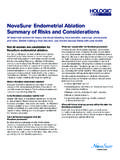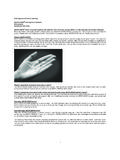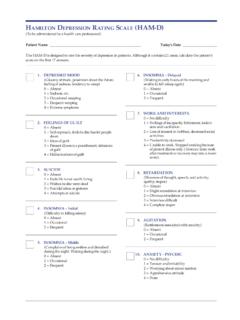Transcription of Laparoscopic Hysterectomy - sydneycare.com.au
1 Laparoscopic Hysterectomy A/Professor Alan Lam MBBS (Hons) FRCOG FRACOG. Director Laparoscopic Hysterectomy Laparoscopic Hysterectomy Hysterectomy Laparoscopic Hysterectomy Laparoscopic Laparoscopic Hysterectomy Laparoscopic Hysterectomy Hysterectomy Laparoscopic Hysterectomy Laparoscopic Laparoscopic Hysterectomy Laparoscopic Hysterectomy Hysterectomy Laparoscopic Hysterectomy Laparoscopic Many women are understandably ambivalent and anxious when told that they may need to undergo Hysterectomy . The term Hysterectomy often conjures up images of a large abdominal cut, prolonged recovery, and anecdotal stories of emotional, psychological, sexual, and hormonal disturbance. When carefully considered and performed for the right indication, Hysterectomy can significantly improve the quality of life for many women. The FAQs provided here may help answer many of the common questions which concern women when deciding whether or not to have a Hysterectomy .
2 What is a Hysterectomy ? Hysterectomy is a major operation for removal of the uterus. As the main functions of the uterus are reproduction and menstruation, a Hysterectomy would therefore mean you no longer can bear children nor have menstruation. What are the reasons or indications for Hysterectomy ? While the reasons for considering Hysterectomy vary from person to person, in general, the main indications are: to relieve pain caused by conditions such as endometriosis, adenomyosis to alleviate excessive menstrual bleeding to relieve pelvic pressure caused by fibroids or by severe prolapse to treat certain cancer of the uterus and ovaries. With the exception of cancer, a decision on whether to undergo a Hysterectomy for other indications is rarely urgent. And so, you should have time to discuss with your doctor the benefits, the risks, and the alternative options before choosing Hysterectomy .
3 What are the alternative options for Hysterectomy ? There are many conservative treatment options before choosing Hysterectomy . The available options obviously depend upon the underlying problems. For instance, women who suffer from menorrhagia (heavy menstruation) may consider medical therapies, Mirena IUCD, or one of the endometrial ablation methods. Women with fibroids who have not started or completed child bearing may have the fibroids removed (myomectomy). Women with endometriosis who suffer from pain and infertility frequently benefit from excision of endometriosis. What are the different types of Hysterectomy ? Total Hysterectomy Removal of the uterus and cervix the ovaries are preserved. In pre-menopausal women, this means there is no change in hormonal status. Subtotal Hysterectomy The cervix of the uterus is preserved routine cervical screening is necessary.
4 Total Hysterectomy and bilateral-salpingo- oophorectomy Removal of the uterus, cervix, ovaries and fallopian tubes in pre-menopausal women this would mean a loss of ovarian hormones. In turn, this means you will go into menopause. In post- menopausal women, there is no hormonal change as the ovaries have already stopped functioning. What are the methods of Hysterectomy ? The three main methods of Hysterectomy are: Vaginal The vaginal route is suitable where the uterus is prolapsed and is not too large in size. Abdominal The abdominal route remains the most common method of Hysterectomy . This means a seven to ten centimetre abdominal incision and a hospital stay of five to seven days. Laparoscopic The Laparoscopic route, performed through three to four small skin incisions, is a safe and effective alternative method to abdominal surgery when performed in the hands of surgeons trained in Laparoscopic surgery.
5 The route of surgery is often determined by the indication for Hysterectomy , the severity of the pathology, and the surgical skills and experience of the surgeon. While it is natural for most women to go for the least invasive method, ultimately, you should discuss with your doctor who will advise and choose the safest route for your Hysterectomy . What are the risks of Hysterectomy ? In general, Hysterectomy is generally considered safe. Complications are uncommon. However, if they occur, the consequence can be serious or even life-threatening and may require further surgery for rectification. The level of risks varies from one case to another. And so, always discuss the risks and benefits of operation with your doctor before making a decision to proceed with Hysterectomy . The following list covers the known potential risks and complications associated with any major surgery including Hysterectomy : Risks associated with general anaesthesia: intubation difficulties, drug allergy, heart problems, lung infection.
6 Infection: at entry wound or at the site of surgery. Bleeding: at entry wound or around the site of surgery. Blood clots in leg veins (thrombosis) with possible clots to the lungs (pulmonary embolism). There are known risks specific to Hysterectomy : Bladder: urine infection, retention, urgency and incontinence, ureteric and bladder injury. Bowels: constipation. Fistula: between the rectum and vagina, or bladder, ureter and vagina. Any of these complications may mean further surgery for correction of the injury. In the case of the bladder or ureter, this may mean prolonged use of urinary catheter. In the case of bowel injury, this may result in leakage of bowel contents, peritonitis, septicaemia. Corrective surgery for bowel injury may require the use of temporary diversion (ileostomy or colostomy). There are some potential risks and complications which are specific to Laparoscopic Hysterectomy : Injury to abdominal wall: bleeding, port site hernia.
7 Conversion to open surgery in case of unexpected complications or findings such as malignancy. Injury to internal abdominal and pelvic organs: bowels, bladder, ureter, blood vessels. This may occur during the insertion phase of the laparoscope or during surgery. There is some concern that bladder or ureteric injury may be more common in Laparoscopic compared to abdominal Hysterectomy . What are the side-effects of Hysterectomy ? Women are often anxious about a range of side-effects when considering Hysterectomy . The common concerns are emotional, hormonal and sexual side-effects. Emotional effects The emotional effects of Hysterectomy vary from person to person and may be expected or unexpected. Some women feel sad and depressed about the loss of reproduction, while others feel relieved as contraception is no longer required. Some women are delighted with the marked improvement in their well-being as Hysterectomy brings to an end of years of chronic pain and heavy bleeding.
8 By talking about your feelings freely with your partner, friends, or your doctor before and after the operation, you will often find a great deal of sympathy and support to help you get through the difficult times. Hormonal effects In general, if you are premenopausal at the time of Hysterectomy and choose to keep the ovaries, you should not experience any sudden hormonal change. If the ovaries are removed, then you can expect the menopausal effects soon after the operation, with symptoms such as hot flushes, insomnia, lethargy and mood fluctuations. In this case, discuss with your doctor about HRT or alternative options. On the other hand, you should notice no difference if the ovaries are removed after your natural menopause. Sexual effects The effect of Hysterectomy on sexuality remains unclear with conflicting evidence from research.
9 This is probably because sexuality is not only personal and hence is often difficult to study and measure, with an array of personal, social, cultural and physiological factors which can influence and affect sexual feelings at any point in time. The Laparoscopic route performed through three to four small incisions, is a safe and effective alternative method to abdominal surgery when performed in the hands of surgeons trained in Laparoscopic surgery. Before your operation You will be notified by your hospital the time to begin fasting and when to arrive for your procedure. The evening prior to your operation, clean your umbilicus (belly button) with a cotton bud, soap and water. This will help reduce the risk of wound infection. How long does the surgery take? On average, an abdominal or vaginal Hysterectomy takes about 60-90 minutes. Laparoscopic Hysterectomy usually takes longer about 70-110.
10 Minutes. The duration of surgery, however, does not affect the post-operative recovery. What happens after surgery? After major surgery, you will have IV fluids until you are able to drink and eat adequately. The catheter to help drain urine from the bladder is removed the following morning. You should be able to have a shower and ambulate the day after surgery. The doctor and nurses will check the wound sites daily. Sutures used to close the wound sites often dissolve by themselves. If non-absorbable sutures are used, they will need to be removed on day five. Post-operative recovery You can expect to have some soreness and pain around the incision sites for several days. You may also experience some shoulder tip or rib cage pain. This is due to a small amount of residual gas under the diaphragm. Peppermint tea, paracetamol and a hot pack applied for a short time to the painful area may be helpful.







